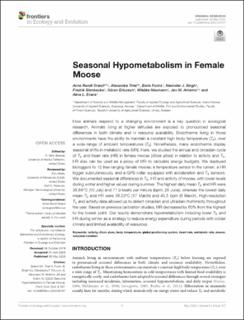| dc.contributor.author | Græsli, Anne Randi | |
| dc.contributor.author | Thiel, Alexandra | |
| dc.contributor.author | Fuchs, Boris | |
| dc.contributor.author | Singh, Navinder J. | |
| dc.contributor.author | Stenbacka, Fredrik | |
| dc.contributor.author | Ericsson, Göran | |
| dc.contributor.author | Neumann, Wiebke | |
| dc.contributor.author | Arnemo, Jon Martin | |
| dc.contributor.author | Evans, Alina L. | |
| dc.date.accessioned | 2021-06-28T15:32:39Z | |
| dc.date.available | 2021-06-28T15:32:39Z | |
| dc.date.created | 2020-09-29T13:00:21Z | |
| dc.date.issued | 2020 | |
| dc.identifier.citation | Frontiers in Ecology and Evolution. 2020, 8, 107 | en_US |
| dc.identifier.issn | 2296-701X | |
| dc.identifier.uri | https://hdl.handle.net/11250/2761737 | |
| dc.description.abstract | How animals respond to a changing environment is a key question in ecological research. Animals living at higher latitudes are exposed to pronounced seasonal differences in both climate and in resource availability. Endotherms living in those environments have the ability to maintain a constant high body temperature (Tb), over a wide range of ambient temperatures (Ta). Nonetheless, many endotherms display seasonal shifts in metabolic rate (MR). Here, we studied the annual and circadian cycle of Tb and heart rate (HR) in female moose (Alces alces) in relation to activity and Ta. HR also can be used as a proxy of MR to calculate energy budgets. We deployed biologgers to 12 free-ranging female moose; a temperature sensor in the rumen, a HR logger subcutaneously, and a GPS collar equipped with acceleration and Ta sensors. We documented seasonal differences in Tb, HR and activity of moose, with lower levels during winter and higher values during summer. The highest daily mean Tb and HR were 38.64◦C (10 July) and 71.9 beats per minute (bpm; 26 June), whereas the lowest daily mean Tb and HR were 38.03◦C (17 March) and 40.5 bpm (6 March). High-resolution Tb and activity data allowed us to detect circadian and ultradian rhythmicity throughout the year. Based on previous calibration studies, MR decreased by 60% from the highest to the lowest point. Our results demonstrate hypometabolism including lower Tb and HR during winter as a strategy to reduce energy expenditure during periods with colder climate and limited availability of resources. | en_US |
| dc.language.iso | eng | en_US |
| dc.rights | Navngivelse 4.0 Internasjonal | * |
| dc.rights.uri | http://creativecommons.org/licenses/by/4.0/deed.no | * |
| dc.subject | activity | en_US |
| dc.subject | Alces alces | en_US |
| dc.subject | body temperature | en_US |
| dc.subject | global positioning system | en_US |
| dc.subject | heart rate | en_US |
| dc.subject | metabolic rate | en_US |
| dc.subject | moose | en_US |
| dc.subject | seasonal variation | en_US |
| dc.title | Seasonal Hypometabolism in Female Moose | en_US |
| dc.type | Peer reviewed | en_US |
| dc.type | Journal article | en_US |
| dc.description.version | publishedVersion | en_US |
| dc.subject.nsi | VDP::Matematikk og Naturvitenskap: 400::Zoologiske og botaniske fag: 480 | en_US |
| dc.source.volume | 8 | en_US |
| dc.source.journal | Frontiers in Ecology and Evolution | en_US |
| dc.identifier.doi | 10.3389/fevo.2020.00107 | |
| dc.identifier.cristin | 1834872 | |
| dc.source.articlenumber | 107 | en_US |
| cristin.ispublished | true | |
| cristin.fulltext | original | |
| cristin.qualitycode | 1 | |

